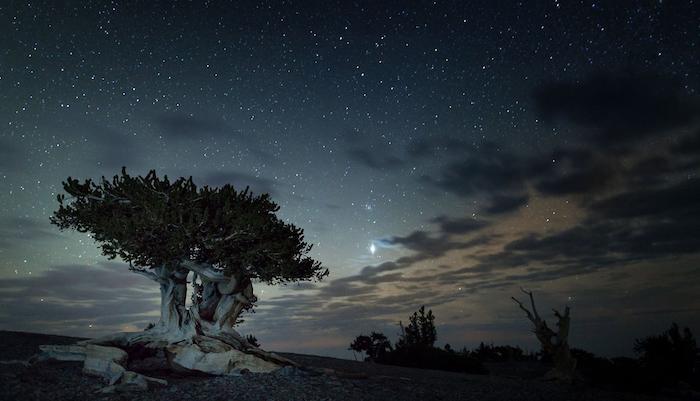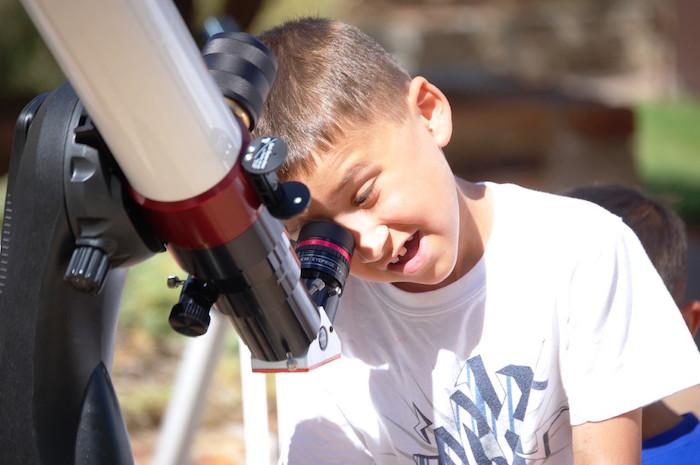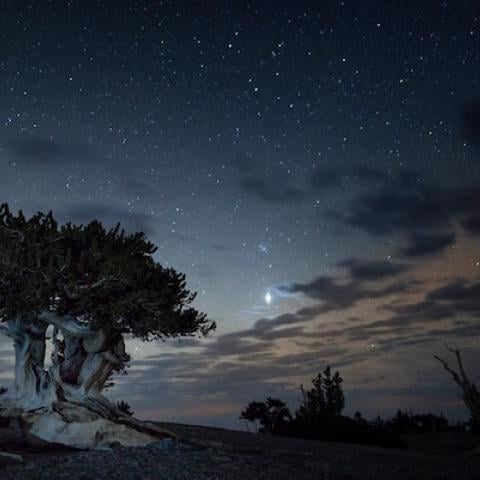
A bristlecone pine against the Milky Way high above Great Basin National Park/NPS
It’s really dark where I’m standing--so dark that I’m fumbling with pen and notebook to jot down the amazed comments of the folks next to me:
“Cool!”
“Oh wow!”
“Fantastic!”
No, we’re not inside Lehman Cave, where rangers like to turn off the lights for a minute or so during their cavern tours to emphasize the pitch darkness underground. We’re at a picnic area close by the visitor center at the cave, where the ninth annual Great Basin Astronomy Festival is underway. The comments I’m hearing (and many others like them) come from visitors who are peering through the eyepieces of more than two dozen telescopes, each operated by an amateur astronomer who volunteers his or her services during the new moon every September. It’s not quite the inky blackness inside a cave, for the sky is spangled with thousands of stars and the Milky Way is so bright, some say it casts a shadow.
As one of the volunteers taking part in the festival, I love to hear such comments from the folks at my telescope. A surprising number of them were seeing our neighboring planets and galaxies “up close” for the first time. This year Saturn was well positioned in the southern sky, and because of its brightness, it’s one of the first objects we trained our instruments on as dusk fell. It’s always a crowd-pleaser:
“Holy cow—you can actually see the rings!” one viewer exclaimed.
“Dude! You gotta see this!” said an excited twenty-something to his companions.
As the night sky darkened further, I set my scope on some classic “deep-sky” objects such as the Veil Nebula in Cygnus, the great “nebula” in Andromeda (it’s actually our neighboring galaxy, some two million light years away), and the stunning star cluster M13 in Hercules. These sights also brought oohs and aahs from observers, as well as pertinent questions: How many stars are there in a globular cluster? What’s the difference between a nebula and a galaxy? How does a white dwarf form? I try to do my homework before these events, just like the National Park Service’s “dark rangers,” who rove the parking lot during the evening to answer questions and point out the major constellations.
All of us, from rank newbie to lifelong stargazer, share a wonder and fascination with the night sky. It’s something we’ve had in common as a species for a very long time—probably since the invention of fire, according to Dr. John Barentine of the International Dark-Sky Association, who gave the keynote talk at this year’s festival. Speaking outside the Lehman Caves Visitor Center* just before dusk, Barentine observed that many of the stories human cultures have passed down through the millennia have to do with the stars.
“All of the great mythological traditions of the world probably developed over the campfire,” he said, noting that once the embers died down, we turned our heads skyward. “The night sky inspires our art and our music,” he said.

The author at the Great Basin Astronomy Festival/Jeremy Stanley/Jeremy Stanley
The reach of our vision was much more limited back then, but what our ancestors did have was a truly dark sky in which to see and appreciate our heavenly neighbors. A clear view of the night sky was still possible in many parts of America well into the 20th century, until nighttime lighting became widespread. But, Barentine warned, “we are losing that space, that commons.” Half of the United States exists under what he termed “perpetual twilight,” the glow created by millions of outdoor light fixtures, car and truck headlights, and other lighting. It’s a problem that is “global and growing out of control,” he said.
Today, only one in five Americans can see the Milky Way from where they live, according to researchers using satellite-based night sky surveys. The advent of bright-white LED outdoor lighting, which is replacing older, sodium-vapor lights in street and highway lighting and commercial buildings, threatens to further degrade dark skies, according to the IDA. That’s a trend the organization hopes to slow down, or even reverse, by promoting the use of more efficient, task-oriented lighting that doesn’t send as much light skyward. Shielding outdoor fixtures, putting lights on timers, closing blinds at night, and choosing bulbs with warmer temperatures (under 3000 degrees Kelvin) all can help reduce light pollution.
National parks in the Southwest have taken a lead in these efforts. In 2007, Natural Bridges National Monument in Utah became the first national park unit to be certified as an International Dark Sky Park by the IDA. Great Basin in Nevada joined this elite list in 2016, and is one of about 60 such parks in the world today. Designation as a dark sky park comes with a commitment by the Park Service to manage outdoor lighting in ways that minimize light leakage to the sky. Great Basin has replaced outdoor lighting at the Lehman Caves Visitor Center with red lights that are turned off a few hours after sunset. Outdated lighting fixtures have been replaced with efficient ones that illuminate only the needed ground surface.
Such efforts help preserve the tremendous nighttime views visitors enjoy at Great Basin. In a letter supporting the park’s application for dark-sky designation, Dr. Tyler Nordgren of the University of Redlands noted that the wide field of view and high-elevation atmosphere at Great Basin give it an advantage over other well-known dark-sky sites, such as Big Bend National Park in Texas. Utah’s Bryce Canyon National Park, which hosts a well-attended astronomy festival each June, is also a terrific place to view the heavens. I’ve attended star parties at Bryce and Natural Bridges as well as at Great Basin, and have witnessed some of the faintest celestial objects I’ve ever seen.

M31, the great galaxy in Andromeda/NPS, Tom Auchter
In places this dark, a fancy telescope isn’t needed to enjoy splendid views of the night sky. At Great Basin’s festival this September, I took breaks from telescope duty to examine the sky through a different set of optics—my eyeglasses. The Milky Way stretched clear across the sky, its prominent dust clouds easily visible. It’s a sight best seen with the unaided eye (well, almost unaided, in my case). Occasionally a meteor streaked overhead, prompting excited comments from those who chanced to see it. We truly had a window into the universe.
The staff at Great Basin understand that their park offers something special when it comes to viewing the night sky.
“Seeing the Milky Way and looking through telescopes have become a central draw for many visitors,” according to Ranger Becky Gillette, an interpretive specialist who coordinates the park’s night sky program.
Besides the annual astronomy festival in September, the park offers three nighttime viewing opportunities at the Lehman Caves Visitor Center each week during summer, each one drawing between 50 and 250 people. Using telescopes owned by the park, rangers and volunteers educate visitors on the importance of dark skies as well as describe astronomical objects. Many of these visitors have never seen the Milky Way, Gillette told me, which helps make their park visit especially memorable.
The park’s interpretive staff also take part in the Nevada Northern Railway’s “star train,” which operates out of Ely and makes stops for riders to look through telescopes. More significant from a scientific standpoint, the non-profit Great Basin National Park Foundation recently raised funds for a research-grade astronomical observatory, which opened in 2016 at a site near the Lehman Caves Visitor Center. The observatory, which is not open to the public, houses a 28-inch telescope that is operated remotely by scientists affiliated with several regional universities, including the University of Nevada at Reno. It’s the first such observatory within a U.S. national park, and is an example of the strong role that science plays within our park system. Great Basin’s dark skies made it a prime site for the observatory.

Solar viewing at the Great Basin Astronomy Festival/NPS, Steve Moore
Most visitors to Great Basin National Park come for daytime activities, including the Lehman Cave tour, seeing bristlecone pines, or perhaps climbing 13,065-foot-high Mt. Wheeler. Still, Great Basin’s rangers take seriously the slogan they’ve adopted, that “half the park is after dark.”
While far fewer people are on park trails after sundown, those who do venture out find a lot to see. Following the festival, I moved up to the Wheeler Peak Campground, located at 9,800 feet elevation, where the view of the nighttime sky (at least away from the trees) is even more stunning. My neighbor in camp turned out to be an avid photographer who was headed out that evening to a nearby bristlecone pine grove. His goal was to photograph the Milky Way rising behind a certain gnarled, ancient tree. The next morning he showed me his photos, explaining that he had to share the space with another photographer who was out to capture the same image.
In our industrialized, brightly lit world, one generally must travel to a national park or wilderness area to enjoy such views. That worries dark-sky advocates such as Barentine, who point out the environmental as well as cultural importance of the night sky. In his evening talk, he pointed out how researchers are uncovering myriad ways in which animals depend on darkness to complete their life cycles, whether it’s songbirds migrating at night or insect pollinators seeking night-blooming desert flowers. Feeding patterns, reproductive behavior, and predator-prey relationships all evolved in conditions of natural lighting, from the near-darkness of a moonless night to the soft glow of a full moon. Even the spectrum of artificial lighting can be at odds with the color of light to which insects, mammals and other animals are adapted. Places like Great Basin National Park give us a baseline against which we can evaluate more light-polluted areas, Barentine said.
Lighting issues, of course, are not confined to the park itself. As Great Basin grows more popular, we could see more tourism development on its fringes, including the tiny village of Baker, Nevada, which serves as the park’s gateway community. Baker has a ways to grow before it becomes a Moab or a Springdale, Utah gateway towns to Arches/Canyonlands and Zion, respectively, but even one or two new motels or RV parks, if illuminated excessively, could significantly interfere with nighttime viewing in the park. Ranger Gillette told me that townspeople in Baker appreciate the park’s dark-sky resource and support efforts to reduce light pollution; one hopes that the community will be proactive and consider adopting a dark-sky ordinance to guide future development. Torrey, Utah, at the outskirts of Capitol Reef National Park, recently adopted such an ordinance, which helped it gain the IDA’s recognition as an International Dark Sky Community--the first park gateway community in the U.S. to earn such designation.
Neither the National Park Service nor the IDA can force local communities to conserve dark skies, but parks such as Great Basin lead by example. With its active astronomical outreach programs, you can bet that at least some park visitors are taking the issue of dark skies back to their own communities. And its rangers are planting seeds in other park units as well: I spoke with Annie Gilliland, a former Great Basin interpretive ranger who attended this year’s festival. She now works at California’s Mojave National Preserve, where she hopes to get a robust night-sky program going.
Concern for preserving nighttime vistas is growing as more communities respond to the public’s interest in astronomy and after-dark photography. The issue is an important one, but during those stellar nights I spent at Great Basin, my mind was somewhere out there in the universe, captivated by stars, nebulae, and galaxies. I imagine that the folks around me were similarly affected. Stargazing can be a lonely occupation if one wishes, but there’s something uplifting about sharing these wondrous sights with others. Perhaps it helps us feel just a little more together as a species, sharing our common heritage of life underneath a very large and very beautiful firmament. It’s an experience worth seeking out and keeping hold of.
* * *
Frederick Swanson writes about the national park and wilderness lands of the western U.S. He’s working on a book detailing the history of Utah’s national parks and monuments. You can visit his website at www.fredswansonbooks.com.
*Note: There’s only one Lehman Cave, but the Park Service, for reasons of history, generally uses the plural. The park also operates the Great Basin Visitor Center at the outskirts of Baker, Nevada.




 Support Essential Coverage of Essential Places
Support Essential Coverage of Essential Places







Comments
nice,very nice.thanks !